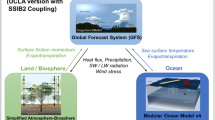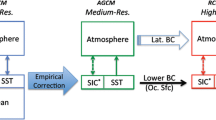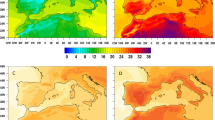Abstract
Conflicting results have been presented regarding the link between Arctic sea-ice loss and midlatitude cooling, particularly over Eurasia. This study analyzes uncoupled (atmosphere-only) and coupled (ocean–atmosphere) simulations by the Climate Forecast System, version 2 (CFSv2), to examine this linkage during the Northern Hemisphere winter, focusing on the simulation of the observed surface cooling trend over Eurasia during the last three decades. The uncoupled simulations are Atmospheric Model Intercomparison Project (AMIP) runs forced with mean seasonal cycles of sea surface temperature (SST) and sea ice, using combinations of SST and sea ice from different time periods to assess the role that each plays individually, and to assess the role of atmospheric internal variability. Coupled runs are used to further investigate the role of internal variability via the analysis of initialized predictions and the evolution of the forecast with lead time.
The AMIP simulations show a mean warming response over Eurasia due to SST changes, but little response to changes in sea ice. Individual runs simulate cooler periods over Eurasia, and this is shown to be concurrent with a stronger Siberian high and warming over Greenland. No substantial differences in the variability of Eurasian surface temperatures are found between the different model configurations. In the coupled runs, the region of significant warming over Eurasia is small at short leads, but increases at longer leads. It is concluded that, although the models have some capability in highlighting the temperature variability over Eurasia, the observed cooling may still be a consequence of internal variability.
摘要
针对北极海冰减少和中纬度地区特别是欧亚地区的变冷之间关系的研究, 存在一些争议或者相冲突的结果. 本文利用CFSv2系统的非耦合大气模式(AMIP)和海洋-大气耦合模式模拟, 来检验北半球冬季的这种关联, 重点是模拟过去30年观测到的欧亚地区的地表变冷趋势. 首先利用非耦合的大气模式并以季节循环的海温(SST)和海冰密集度(SIC)作为强迫场驱动, 选取不同时期的平均SST和SIC, 并通过SST和SIC之间的多种组合强迫, 分析强迫场及大气内部变化的影响. 进一步利用海洋-大气耦合模式, 通过初始化预测及提前预报的演变, 分析大气内部变化的作用.
AMIP模拟结果显示, 由于海温变化, 欧亚地区平均增暖, 但欧亚气温对海冰变化几乎没有响应. 个别试验模拟出了较低的欧亚气温, 同时出现的是较强的西伯利亚高压和格陵兰岛的增暖. 不同的模式配置(即不同的海温海冰强迫组合)并不会造成欧亚表面温度变化的明显差异. 耦合试验结果显示, 短期预测试验模拟的欧亚显著增暖区域很小, 但随着预报时段的增长, 更多的欧亚区域变暖. 因此, 尽管模式具有突出欧亚大陆温度变化的能力, 但观测到的地表变冷仍可能是大气内部变率的结果.
Similar content being viewed by others
References
Alexander, M. A., U. S. Bhatt, J. E. Walsh, M. S. Timlin, J. S. Miller, and J. D. Scott, 2004: The atmospheric response to realistic Arctic sea ice anomalies in an AGCM during winter. J. Climate, 17, 890–905, https://doi.org/10.1175/1520-0442(2004)017<0890:TARTRA>2.0.CO;2.
Ayarzagüena, B., and J. A. Screen, 2016: Future Arctic sea ice loss reduces severity of cold air outbreaks in midlatitudes. Geophys. Res. Lett., 43, 2801–2809, https://doi.org/10.1002/2016GL068092.
Barnes, E. A., 2013: Revisiting the evidence linking Arctic amplification to extreme weather in midlatitudes. Geophys. Res. Lett., 40, 4734–4739, https://doi.org/10.1002/grl.50880.
Barnes, E. A., E. Dunn-Sigouin, G. Masato, and T. Woollings, 2014: Exploring recent trends in Northern Hemisphere blocking. Geophys. Res. Lett., 41, 638–644, https://doi.org/10.1002/2013GL058745.
Chen, M.Y., W. Q. Wang, and A. Kumar, 2013: Lagged ensembles, forecast configuration, and seasonal predictions. Mon. Wea. Rev., 141, 3477–3497, https://doi.org/10.1175/MWRD-12-00184.1.
Cohen, J. L., J. C. Furtado, M. Barlow, V. A. Alexeev, and J. E. Cherry, 2012: Asymmetric seasonal temperature trends. Geophys. Res. Lett., 39, L04705, https://doi.org/10.1029/2011GL050582.
Cohen, J., and Coauthors, 2014: Recent Arctic amplification and extreme mid-latitude weather. Nature Geoscience, 7, 627–637, https://doi.org/10.1038/NGEO2234.
Comiso, J. C., C. L. Parkinson, R. Gersten, and L. Stock, 2008: Accelerated decline in the arctic sea ice cover. Geophys. Res. Lett., 35, L01703, https://doi.org/10.1029/2007GL031972.
Dee, D. P., and Coauthors, 2011: The ERA-Interim reanalysis: Configuration and performance of the data assimilation system. Quart. J. Roy. Meteor. Soc., 137, 553–597, https://doi.org/10.1002/qj.828.
Deser, C., G. Magnusdottir, R. Saravanan, and A. Phillips, 2004: The effects of North Atlantic SST and sea ice anomalies on the winter circulation in CCM3. Part II: Direct and indirect components of the response. J. Climate, 17, 877–889, https://doi.org/10.1175/1520-0442(2004)017<0877:TEONAS>2.0.CO;2.
Ding, Q. H., and Coauthors, 2017: Influence of high-latitude atmospheric circulation changes on summertime Arctic sea ice. Nat. Clim. Change, 7, 289–295, https://doi.org/10.1038/nclimate3241.
Francis, J. A., and S. J. Vavrus, 2012: Evidence linking Arctic amplification to extreme weather in mid-latitudes. Geophys. Res. Lett., 39, L06801, https://doi.org/10.1029/2012GL051000.
Francis, J. A., and S. J. Vavrus, 2015: Evidence for a wavier jet stream in response to rapid Arctic warming. Environmental Research Letters, 10, 014005, https://doi.org/10.1088/1748-9326/10/1/014005.
Furtado, J. C., J. L. Cohen, A. H. Butler, E. E. Riddle and A. Kumar, 2015: Eurasian snow cover variability and links to winter climate in the CMIP5 models. Climate Dyn., 45, 2591–2605, https://doi.org/10.1007/s00382-015-2494-4.
Gao, Y. Q., and Coauthors, 2015: Arctic sea ice and Eurasian climate: A review. Adv. Atmos. Sci., 32, 92–114, https://doi.org/10.1007/s00376-014-0009-6.
Griffies, S. M., M. J. Harrison, R. C. Pacanowski, and A. Rosati, 2003: Technical guide to MOM4. GFDL Ocean Group Technical Report No. 5, NOAA/Geophysical Fluid Dynamics Laboratory, 337 pp. [Available online at www.gfdl.noaa.gov/~fms.]
Handorf, D., R. Jaiser, K. Dethloff, A. Rinke, and J. Cohen, 2015: Impacts of Arctic sea ice and continental snow cover changes on atmospheric winter teleconnections. Geophys. Res. Lett., 42, 2367–2377, https://doi.org/10.1002/2015GL063203.
Hartmann, D. L., and Coauthors, 2013: Observations: Atmosphere and Surface. Climate Change 2013: The Physical Science Basis. Contribution of Working Group I to the Fifth Assessment Report of the Intergovernmental Panel on Climate Change, T. F. Stocker et al., Eds., Cambridge University Press, Cambridge, United Kingdom, New York, NY, USA, 159–254.
Honda, M., J. Inoue, and S. Yamane, 2009: Influence of low arctic sea-ice minima on anomalously cold Eurasian winters. Geophys. Res. Lett., 36, L08707, https://doi.org/10.1029/2008GL037079.
Hurrell, J. W., J. J. Hack, D. Shea, J. M. Caron, and J. Rosinski, 2008: A new sea surface temperature and sea ice boundary dataset for the community atmosphere model. J. Climate, 21, 5145–5153, https://doi.org/10.1175/2008JCLI2292.1.
Inoue, J., M. E. Hori, and K. Takaya, 2012: The role of Barents Sea ice in the wintertime cyclone track and emergence of a warm-arctic cold-Siberian anomaly. J. Climate, 25, 2561–2568, https://doi.org/10.1175/JCLI-D-11-00449.1.
Johansson, A., 2007: Prediction skill of the NAO and PNA from daily to seasonal time scales. J. Climate, 20, 1957–1975, https://doi.org/10.1175/JCLI4072.1.
Kumar, A., and Coauthors, 2010: Contribution of sea ice loss to Arctic amplification. Geophys. Res. Lett., 37, L21701, https://doi.org/10.1029/2010GL045022.
Liu, J. P., J. A. Curry, H. J. Wang, M. R. Song, and R. M. Horton, 2012: Impact of declining Arctic sea ice on winter snowfall. Proceedings of the National Academy of Sciences of the United States of America, 109(11), 4074–4079, https://doi.org/10.1073/pnas.1114910109.
McCusker, K. E., J. C. Fyfe, and M. Sigmond, 2016: Twentyfive winters of unexpected Eurasian cooling unlikely due to Arctic sea-ice loss. Nature Geoscience, 9, 838–842, https://doi.org/10.1038/NGEO2820.
Moorthi, S., H.-L. Pan, and P. Caplan, 2001: Changes to the 2001 NCEP operational MRF/AVN global analysis/forecast system. NOAA Technical Bulletin No. 484, National Centers for Environmental Prediction, Washington, DC, 14 pp.
Mori, M., M. Wananabe, H. Shiogama, J. Inoue, and M. Kimoto, 2014: Robust Arctic sea-ice influence on the frequent Eurasian cold winters in past decades. Nature Geoscience, 7, 869–873, https://doi.org/10.1038/NGEO2277.
Nakamura, T., K. Yamazaki, K. Iwamoto, M. Honda, Y. Miyoshi, Y. Ogawa, and J. Ukita, 2015: A negative phase shift of the winter AO/NAO due to the recent Arctic sea-ice reduction in late autumn. J. Geophys. Res., 120, 3209–3227, https://doi.org/10.1002/2014JD022848.
Overland, J. E., J. A. Francis, R. Hall, E. Hanna, S.-J. Kim, and T. Vihma, 2015: The melting Arctic and midlatitude weather patterns: are they connected? J. Climate, 28, 7917–7932, https://doi.org/10.1175/JCLI-D-14-00822.1.
Overland, J. E., 2016: A difficult Arctic science issue: Midlatitude weather linkages. Polar Science, 10, 210–216, https://doi.org/10.1016/j.polar.2016.04.011.
Perlwitz, J., M. Hoerling, and R. Dole, 2015: Arctic tropospheric warming: causes and linkages to lower latitudes. J. Climate, 28, 2154–2167, https://doi.org/10.1175/JCLI-D-14-00095.1.
Petoukhov, V., and V. A. Semenov, 2010: A link between reduced Barents-Kara sea ice and cold winter extremes over northern continents. J. Geophys. Res., 115, D21111, https://doi.org/10.1029/2009JD013568.
Riddle, E. E., A. H. Butler, J. C. Furtado, J. L. Cohen, and A. Kumar, 2013: CFSv2 ensemble prediction of the wintertime Arctic Oscillation. Climate Dyn., 41, 1099–1116, https://doi.org/10.1007/s00382-013-1850-5.
Saha, S., and Coauthors, 2010: The NCEP climate forecast system reanalysis. Bull. Amer. Meteor. Soc., 91, 1015–1057, https://doi.org/10.1175/2010BAMS3001.1.
Saha, S., and Coauthors, 2014: The NCEP climate forecast system version 2. J. Climate, 27, 2185–2208, https://doi.org/10.1175/JCLI-D-12-00823.1.
Sato, K., J. Inoue, and M. Watanabe, 2014: Influence of the Gulf Stream on the Barents Sea ice retreat and Eurasian coldness during early winter. Environmental Research Letters, 9, 084009, https://doi.org/10.1088/1748-9326/9/8/084009.
Screen, J. A., C. Deser, and I. Simmonds, 2012: Local and remote controls on observed Arctic warming. Geophys. Res. Lett., 39, L10709, https://doi.org/10.1029/2012GL051598.
Screen, J. A., C. Deser, I. Simmonds, and R. Tomas, 2014: Atmospheric impacts of Arctic sea-ice loss, 1979–2009: Separating forced change from atmospheric internal variability. Climate Dyn., 43, 333–344, https://doi.org/10.1007/s00382-013-1830.9.
Screen, J. A., and I. Simmonds, 2013: Exploring links between Arctic amplification and mid-latitude weather. Geophys. Res. Lett., 40, 959–964, https://doi.org/10.1002/GRL.50174.
Screen, J. A., 2014: Arctic amplification decreases temperature variance in northern mid- to high-latitudes. Nat. Clim. Change, 4, 577–582, https://doi.org/10.1038/NCLIMATE2268.
Screen, J. A., C. Deser, and L. T. Sun, 2015: Reduced risk of North American cold extremes due to continued Arctic sea ice loss. Bull. Amer. Meteor. Soc., 96, 1489–1503, https://doi.org/10.1175/BAMS-D-14-00185.1.
Serreze, M. C., M. M. Holland, and J. Stroeve, 2007: Perspectives on the Arctic’s shrinking sea-ice cover. Science, 315, 1533–1536, https://doi.org/10.1126/science.1139426.
Serreze, M. C., and R. G. Barry, 2011: Processes and impacts of Arctic amplification: A research synthesis. Global and Planetary Change, 77, 85–96, https://doi.org/10.1016/j.gloplacha.2011.03.004.
Sillmann, J., M. G. Donat, J. C. Fyfe, and F.W, Zwiers, 2014: Observed and simulated temperature extremes during the recent warming hiatus. Environmental Research Letters, 9, 064023, https://doi.org/10.1088/1748-9326/9/6/064023.
Sun, L. T., J. Perlwitz, and M. Hoerling, 2016: What caused the recent “Warm Arctic, Cold Continents” trend pattern in winter temperatures? Geophys. Res. Lett., 43, 5345–5352, https://doi.org/10.1002/2016GL069024.
Tang, Q. H., X. J. Zhang, X. H. Yang, and J. A. Francis, 2013: Cold winter extremes in northern continents linked to arctic sea ice loss. Environmental Research Letters, 8, 014036, https://doi.org/10.1088/1748-9326/8/1/014036.
Wallace, J. M., I. M. Held, D. W. J. Thompson, K. E. Trenberth, and J. E. Walsh, 2014: Global warming and winter weather. Science, 343, 729–730, https://doi.org/10.1126/science/343/6172.729.
Zhang, X. D., C. H. Lu, and Z. Y. Guan, 2012: Weakened cyclones, intensified anticyclones and recent extreme cold winter weather events in Eurasia. Environmental Research Letters, 7, 044044, https://doi.org/10.1088/1748-9326/7/4/044044.
Acknowledgements
This work is supported by the NOAA Climate Program Office Climate Variability and Predictability Program. We thank Qin ZHANG (CPC), Kirstin HARNOS (INNOVIM/ CPC), and the two anonymous reviewers for their assessment of this manuscript.
Author information
Authors and Affiliations
Corresponding author
Rights and permissions
About this article
Cite this article
Collow, T.W., Wang, W. & Kumar, A. Simulations of Eurasian winter temperature trends in coupled and uncoupled CFSv2. Adv. Atmos. Sci. 35, 14–26 (2018). https://doi.org/10.1007/s00376-017-6294-0
Received:
Revised:
Accepted:
Published:
Issue Date:
DOI: https://doi.org/10.1007/s00376-017-6294-0




